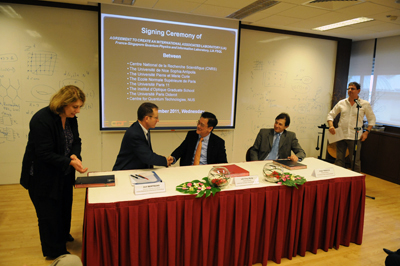Highlights
Ceremony marks creation of International Associated Laboratory by CQT and French partners
A signing ceremony on 9 November at CQT inaugurated an International Associated Laboratory (LIA) that will facilitate collaboration between CQT and research centres affiliated with the French public research organisation the Centre National de la Recherche Scientifique (CNRS).
An LIA is a "laboratory without walls" — an agreement at the institutional level that provides a structure for the exchange of people and funds. The France-Singapore Quantum Physics and information Laboratory (LIA FSQL), formalised in the signing ceremony, grows from ongoing successful joint projects.

Senior representatives from CNRS, CQT, and NUS attended the signing ceremony.
The parties involved from France are CNRS, the Université de Nice Sophia Antipolis, the Université Pierre et Marie Curie, the Ecole Normale Supérieure de Paris, The Université Paris-Sud 11, the Institut d'Optique Graduate School, and the Université Paris Diderot Paris.
"Today we see that we are going to be having very in depth interaction with many of the leading institutions in France today as well as CNRS. I think both for the National University of Singapore as well as the Centre for Quantum Technologies, it is indeed very exciting," said Lai Choy Heng, CQT's Deputy Director and at NUS Vice Provost (Academic Personnel).

Pictured seated after signing the documents are Joël Bertrand of CNRS (left), Lai Choy Heng of CQT at NUS (centre), and Jorge Tredicce from Université de Nice Sophia Antipolis(right). On the far right is Christian Miniatura.
Present to sign the agreement were Joël Bertrand, Director General for Science at CNRS and Jorge Tredicce for the Université de Nice Sophia Antipolis. Other representatives from CNRS and NUS also attended the signing.
"I am really excited this has gone through. The LIA gives us a lot of visibility in France and the official structure helps us," says Christian Miniatura, a Visiting Research Professor at CQT on secondment from the CNRS Institut Non-Linéaire de Nice (INLN), at the Université de Nice Sophia Antipolis, who initiated collaborations with CQT Principal Investigator Berge Englert as long ago as 2005. Christian and Berge run the LIA as co-principal investigators.
Other researchers have also contributed to the strong France-Singapore quantum connection. For example, Miklos Santha, a CQT Principal Investigator who helped establish CQT's computer science group, is from the CNRS Laboratoire d'Informatique Algorithmique: Fondements et Applications at the Université Paris Diderot Paris. David Wilkowski, a Visiting Research Associate Professor at CQT who is setting up an experimental lab at Singapore's Nanyang Technological University, is from INLN. CQT has also had Benoît Grémaud from the Laboratoire Kastler Brossel at the Université Pierre et Marie Curie on secondment as a Visiting Associate Professor, working on the theory of quantum gases with Christian and Berge.
Funds made available through the creation of the LIA FSQL will support further exchange of staff and students between the named parties. This initial agreement establishes the LIA FSQL until January 2014.
CNRS's presence in Singapore includes another LIA, signed into existence with the Mechanobiology Institute at NUS on 8 November, and two established "International Joint Units" (laboratories with walls) — the Image and Pervasive Access Lab and CINTRA.
Joël Bertrand of CNRS said during the ceremony, "For us, Singapore is a major place for scientific cooperation. When I say major place, what does that mean? In the world, there are only probably 4 or 5 or 6 major places for us, and Singapore is one of these places."

CNRS representatives toured CQT's laboratories.






